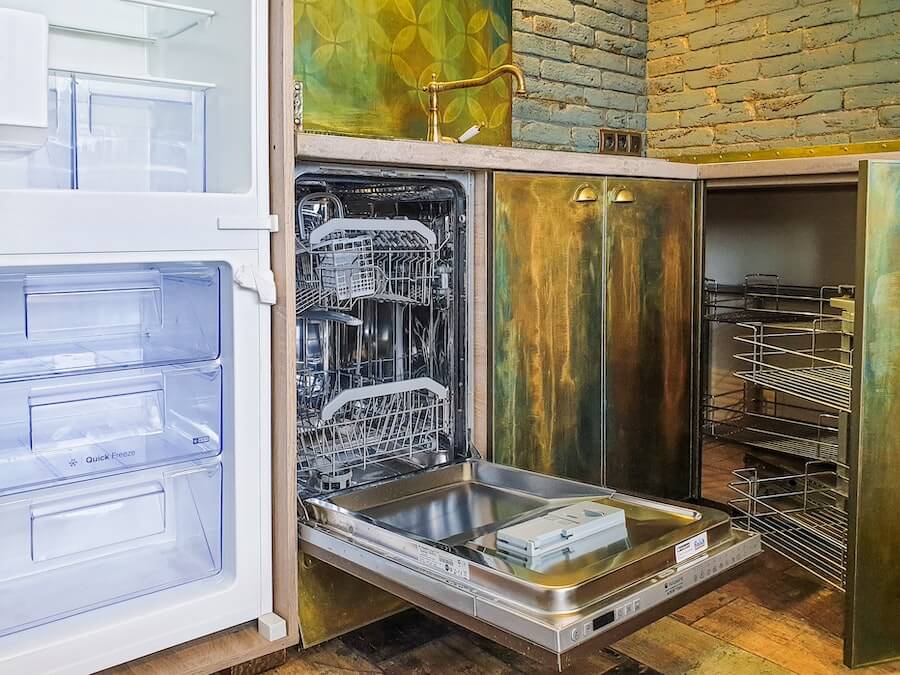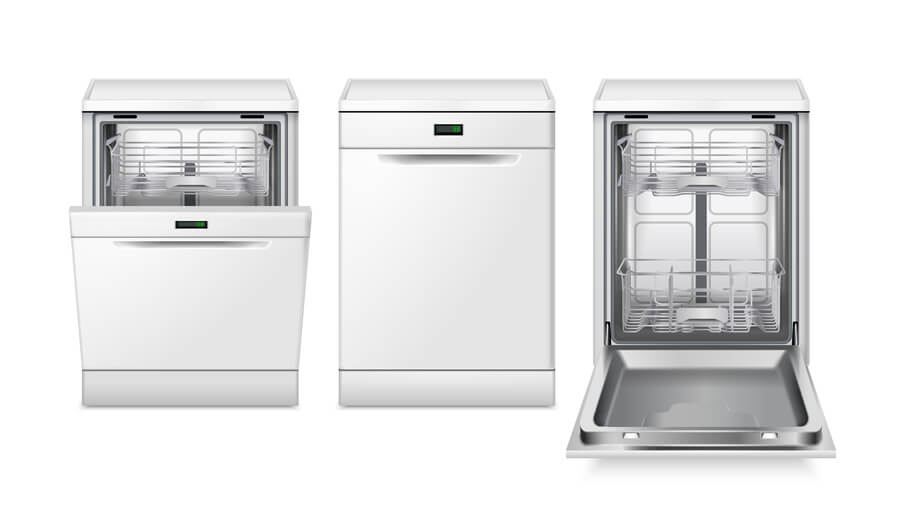When washing your dishes with a dishwasher, some batches come out clean, and some do not. If you’re using the dishwasher according to the manual, it should work in an optimum condition. However, if your top rack is sparkling and the bottom frame remains unclean, read on to find a solution.

Why your dishwasher is not Cleaning the Bottom Rack and How to Fix it
1. The Spray Arm is Clogged
Dishwashers have spray arms, typically on the upper side and the lower side. The spray arm is responsible for distributing water to clean the dishes. When the small holes on the spray arm get clogged, water can’t flow properly. This leads to poor cleaning. Over time, debris can clog the spray arm’s nozzles, restricting water flow.
Solution:
- Pull out the bottom rack to access the spray arm. Ensure that the small holes on the spray arm are clear.
- Check the spray arm for food particles, debris, or dirt buildup. They may be clogging the spray arm’s nozzles.
- Clean the spray arm. Gently remove obstructions using a brush, toothpick, or a small wire. Be careful not to damage the nozzles. Remove the spray arm gently and clean the nozzles.
- Once everything is clean, run an empty cycle with a dishwasher cleaner to remove any remaining debris.
2. The Filter is Dirty
Dishwashers have a filter system that captures debris or food particles. This prevents them from recirculating and potentially clogging the spray arms and nozzles. A dirty or clogged filter can hinder water circulation in your dishwater. In turn, this can lead to the bottom rack needing to be cleaned properly.
Solution:
- Clean out the filter. Refer to your dishwasher’s user manual to find the location of the filter. Typically, most dishwashers have a filter at the bottom, near the spray arm. Ensure it’s clean and not clogged, which can affect water flow.
- You can use a brush or a soft cloth to remove the accumulated debris. Then, rinse it with warm water.
- Replace the filter if needed. Do this according to your dishwasher’s manual. After cleaning, reassemble the filter and ensure it’s securely in place.
3. The Dishwasher Isn’t Loaded Properly
When you overload the bottom rack with too many dishes, it restricts the flow of water and detergent. Also, stacking them haphazardly can block the water spray. This can result in dishes needing adequate exposure to the cleaning action.
Solution:
- Manufacturers usually guide the manual on the best way to load dishes for optimal cleaning.
- Load dishes according to the manufacturer’s recommendations and ensure they don’t block the spray arm.
- Avoid overcrowding the bottom rack. Leave enough space between dishes for water and detergent to reach all surfaces.
- Always position the dishes wisely. Place plates, pots, and pans in a way that allows water to flow freely. Arrange heavily soiled surfaces toward the spray arms.

4. Water Inlet Valve Issue
The water inlet valve controls the flow of water into the dishwasher. It opens to allow water in and closes to stop the flow when the dishwasher is unused. Where a water inlet valve is malfunctioning, it may not allow sufficient water into the dishwasher.
Without adequate water, the dishwasher won’t have enough fluid to mix with detergent and reach all areas of the dishes in the lower rack. Hence, the cleaning is compromised, and the bottom shelf may need to be adequately cleaned.
Solution:
- Depending on the extent of the issue, you may need to clean any debris blocking the valve.
- In other cases, replace the valve if it’s damaged or worn out.
- You want to seek professional service for a thorough diagnosis or repair.
5. Faulty Detergent Dispenser
If the detergent dispenser doesn’t open at the right time, it won’t clean dishes properly. Sometimes, the detergent dispenser may release too little or too much detergent. If it releases too little, there won’t be enough to handle the grease and grime on the bottom rack dishes. On the other hand, too much detergent can lead to excessive suds, causing poor cleaning.
Solution:
- Inspect the detergent dispenser and replace it if necessary.
- Ensure you are using the right amount of detergent. Refer to the dishwasher’s manual for the correct amount you ought to use.
- Invest in a high-quality dishwasher detergent. Use one that is designed for your dishwasher’s type and water hardness.
- If the detergent dispenser is defective, it may need to be repaired or replaced by a professional.
6. Worn Spray Arm Bearing
Spray arms have miniature bearings that allow them to rotate or spin during a wash cycle. The rotation allows for directing pressurized water at dishes from various angles. This is important to ensure thorough cleaning.
However, over time, as you use the spray arm and expose it to water, the bearing can become worn. This can hinder the proper movement of the spray arm.
Solution:
- If you suspect the spray arm bearing is worn, inspect it first.
- Replace the spray arm assembly if the bearings are damaged.
- Most dishwashers will allow for the replacement of worn bearings. You can usually order replacement parts from the manufacturer or an appliance parts supplier.
7. Water Pressure is low.
Dishwashers rely on a solid and consistent water flow to spray and rinse water throughout the washer. When the water pressure is too low, the dishwasher’s spray arms may not rotate properly, and the water distribution is uneven.
Solution:
- Make sure your home’s overall water pressure is adequate. If it’s low, you may need to contact your water utility provider or a plumber to address the issue.
- Examine your water supply line for any obstructions or kinks.
8. The dishwasher needs to be set up correctly.
Some dishwashers can be set to wash either the top or bottom rack only at once. This setting can save water and time, but it needs to be selected correctly.
Solution:
- Review the dishwasher’s settings to ensure that it is configured to wash both the top and bottom racks at once. In this case, you have to consult the user manual for guidance.
9. Faulty Pump Motor
The pump motor in a dishwasher mainly pumps water into the dishwasher and circulates the water within the machine. During the wash cycle, it pumps water through the spray arms to ensure an even distribution of water and detergent over the dishes.
In the rinse cycle, it flushes away detergent and food residues. If the pump motor isn’t working correctly, it can’t perform these tasks.
Solution:
- In the case of a faulty pump motor, it’s advisable to have a professional dishwasher technician inspect it. They can diagnose the exact issue.

10. Blocked Drain Hose
The drain hose carries away the dirty water from the inside of the dishwasher into your home’s plumbing or drainage system. However, when the drain hose is blocked, it prevents proper drainage. Then, dirty water recirculates into the washer, and you discover your dishes remain unclean.
Solution:
- Check the drain hose for obstructions and clear any blockages.
- One way to prevent future blockage is to rinse dishes before placing them in the dishwasher. This would reduce the likelihood of food particles entering the drain hose.
Finally,
If you’ve tried these solutions and your dishwasher still doesn’t clean the bottom rack effectively, you need external support. Consult the manufacturer’s customer support or a professional technician who deals with dishwashers. Sometimes, the appliance must be dismantled, which you need help managing.
